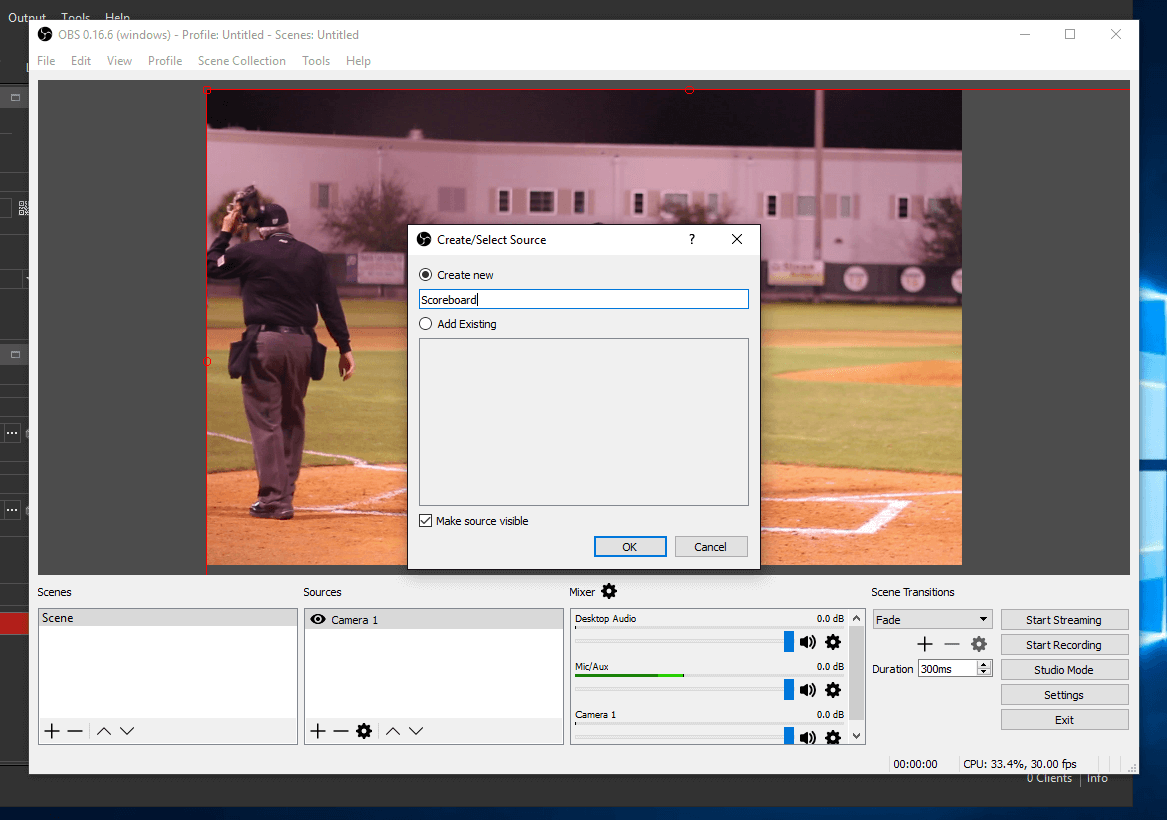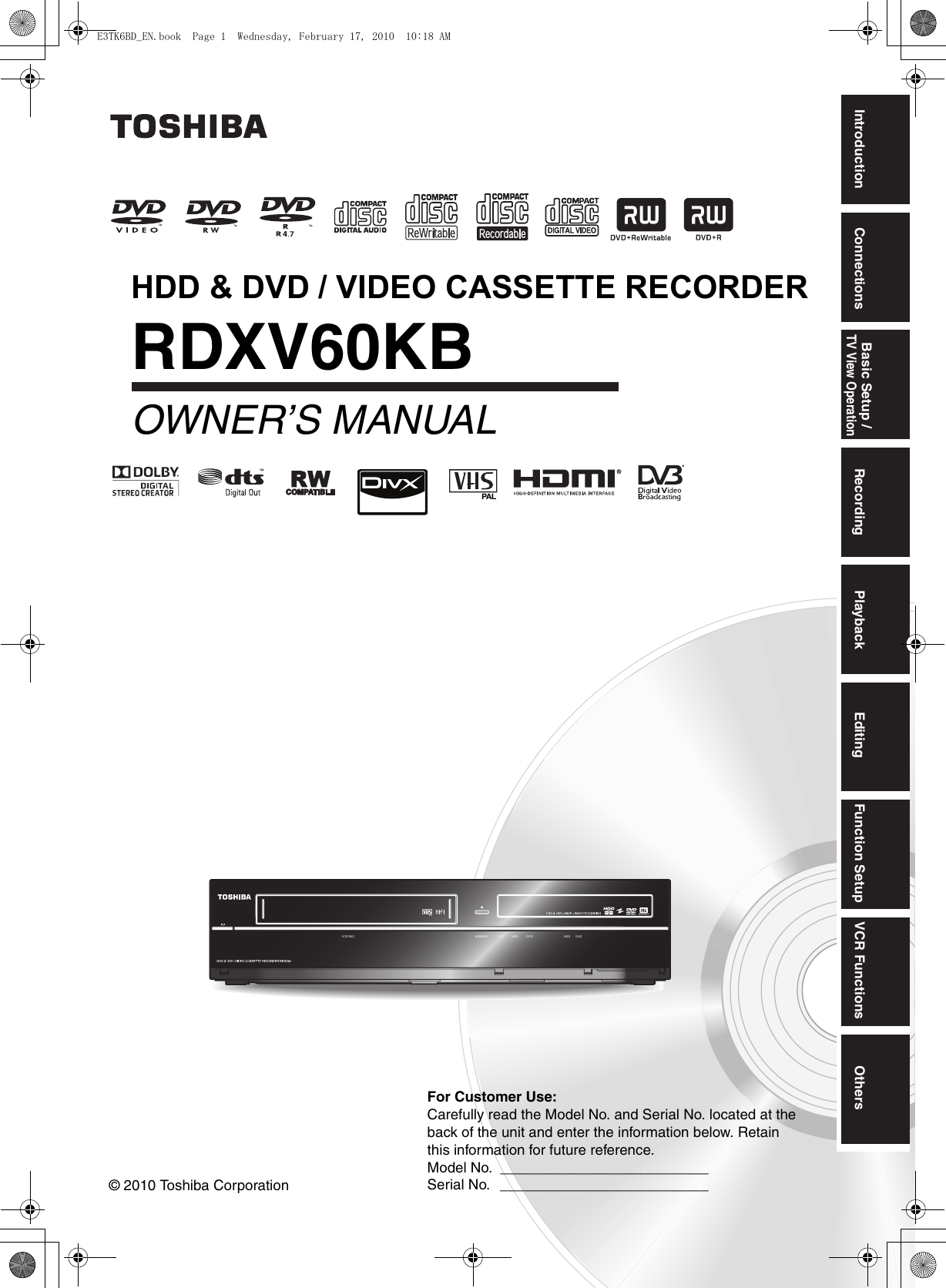Broadcaster Software
| Original author(s) | Hugh 'Jim' Bailey |
|---|---|
| Developer(s) | Community |
| Initial release | v0.32a / 1 September 2012; 8 years ago[1] |
| Stable release | 26.1.1 / 6 January 2021; 27 days ago[2] |
| Repository | |
| Written in | C, C++[2] |
| Operating system | Windows 8 and later, macOS 10.13 and later, Linux[3] |
| Platform | IA-32 and x86-64 |
| Available in | 59 languages[4] |
| |
| Type | Software vision mixer, streaming media |
| License | GNU General Public License, version 2[5] |
| Website | obsproject.com |
Open Broadcaster Software Studio, more commonly known as OBS, is a video streaming and recording program. It's free, open source, and fully cross-platform — Mac, Windows and Linux. When combined with solid audio and video editing software it is a powerful and flexible screencast video production tool.
- Open Broadcaster Software is free and open source software for the purposes of streaming live media content to the internet or to video files. Originally I made Open Broadcaster Software for myself because I thought 'why should I pay a subscription for software I could probably write?' And so, I did and Open Broadcaster Software.
- StationPlaylist Studio: Studio is a simple to use on-air broadcast automation playout software for the studio and/or DJ. Plays all your media files with manual or intelligent / automatic.
Open Broadcaster Software (OBS) is a free and open-source cross-platform streaming and recording program built with Qt and maintained by the OBS Project. As of 2016, the software is now referred to as OBS Studio.[6] There are versions of OBS Studio available for Microsoft Windows, macOS, and Linux distributions. OBS is funded on Open Collective.
Overview[edit]
OBS Studio is a free and open-source software suite for recording and live streaming. Written in C, C++ and Qt, OBS provides real-time source and device capture, scene composition, encoding, recording, and broadcasting. Transmission of data is primarily done via the Real Time Messaging Protocol (RTMP) and can be sent to any RTMP supporting destination, including many presets for streaming websites such as YouTube, Twitch, Instagram and Facebook.[7]
For video encoding, OBS Studio is capable of using the x264free softwarelibrary,[8]Intel Quick Sync Video, Nvidia NVENC and the AMD Video Coding Engine to encode video streams into the H.264/MPEG-4 AVC format and the H.265/HEVC format.[9] Multiple tracks of audio can be encoded using the AAC codec. Advanced users can choose to use any codecs and containers available in libavcodec / libavformat as well as output the stream to a custom ffmpeg URL.[10]

User interface[edit]
The main user interface is organized into five sections: scenes, sources, audio mixer, transitions, and controls. Scenes are groups of sources like live and recorded video, text and audio. The mixer panel lets the user mute the audio, and adjust the volume through virtual faders, and apply effects by pressing the cogwheel next to the mute button. The control panel has options for starting/stopping a stream or recording, a button to transform OBS to a more professional Studio Mode (see below), a button for opening the settings menu and a button to exit the program. The upper section has a live video preview, used to monitor and edit the current scene. The user interface can be switched to a variety of themes, including both dark and light themes, depending on what the user prefers.
When in Studio Mode, there are two canvas preview windows, the left one for modifying and preview of non-active scenes, while the right window is for preview of the live scene ('Preview' and 'Program' respectively). In the middle there is a secondary transition button, allowing for transitioning to the non-active scene in the left window using user-defined 'quick transitions'.
There are some simple tutorials on the Internet that show how to use Open Broadcaster Software,[11][12][13] including more in-depth tutorials designed to cover every aspect of the application.[14]
History[edit]
Open Broadcaster Software started out as a small project created by Hugh 'Jim' Bailey, but quickly grew with the help of many online collaborators working both to improve OBS and spread the knowledge about the program. In 2014,[15] development started on a rewritten version known as OBS Multiplatform (later renamed OBS Studio) for multi-platform support, a more thorough feature set, and a more powerful API.[16] In 2016, OBS 'Classic' was no longer supported with OBS Studio becoming the primary version.[17]
Plug-ins[edit]
Open Broadcaster Software supports a variety of plug-ins[3] to extend its functionality. Plug-ins are loaded as native dynamic libraries,[18] although a wrapper plug-in[19] is available that allows hosting of plug-ins written in the .NET Framework.
See also[edit]
References[edit]
- ^'Open Broadcaster Software - Changelog'. The OBS Project. Archived from the original on 17 May 2013. Retrieved 13 October 2020.
- ^ ab'Download OBS'. The OBS Project. Retrieved 8 January 2021.
- ^ ab'Open Broadcaster Software OBS'. The OBS Project. Retrieved 13 October 2020.
- ^'Locales'. The OBS Project. Retrieved 13 October 2020.
- ^'COPYING'. obsproject/obs-studio. Retrieved 13 October 2020 – via GitHub.
- ^'OBS Classic is no longer supported - Here's how to easily switch to OBS Studio'. The OBS Project. Retrieved 26 March 2020.
- ^'How to stream games with Open Broadcaster: a fast, free livestreaming application - News - PC Gamer'. Future Publishing Limited. Retrieved 2 June 2013.
- ^'x264 Home Page'. VideoLan Organization. Retrieved 11 March 2011.
In addition to being free to use under the GNU GPL, x264 is also available under a commercial license from x264 LLC and CoreCodec.
- ^'General Performance And Encoding Issues'. obsproject.com.
- ^'Surround Sound Streaming And Recording OBS'. obsproject.com.
- ^'How To Use OBS For Streaming'. Answerslave. Retrieved 7 March 2018.
- ^'What is an OBS – How to Use it for Live Streaming'. Broodle. 21 December 2017. Retrieved 10 March 2018.
- ^'How to live Stream Any Video To Facebook Page Using OBS'. techsite.io. Retrieved 19 November 2018.
- ^EposVox (28 December 2017), The Most In-Depth OBS Studio Tutorial Course Ever Made OBS STUDIO MASTER CLASS 2018, retrieved 12 May 2019
- ^'Releases'. obsproject/obs-studio. Retrieved 25 February 2016 – via Github.
- ^'OBS Homepage'. The OBS Project. Archived from the original on 9 March 2016. Retrieved 25 February 2016.
- ^'OBS Classic is no longer supported - Here's how to easily switch to OBS Studio'. The OBS Project. Retrieved 30 April 2017.
- ^'Plugins — OBS Studio 24.0.0 documentation'. obsproject.com.
- ^Bradley, John R. (11 August 2013). 'Creating a Plugin'. CatchException. Archived from the original on 23 October 2016. Retrieved 23 October 2016.
... All languages based on Microsoft’s Common Language Runtime (.NET) should be fine. This includes C#, C++/cli, Visual Basic and others. ...
External links[edit]

- Official website
- obs-studio on GitHub
It is necessary to have an encoder or another third-party automation application in order to go live on your Live365 station. Luckily, many programs are compatible with the Live365 platform. Below are 15 of the most-used applications with Live365 stations.
AltaCast
AltaCast is available on Windows. It runs as a standalone encoder, but also works with various media players that are compatible with Winamp plugins.
- Cost: Free
Audio Hijack
Audio Hijack was recommended by the folks at Nicecast after it retired in early 2018. It is available on MacOS and offers features like Volume Overdrive, live stream capabilities, VoIP Recording, and more.
- Cost: Free trial, $59 with bundles available
BUTT (Broadcast Using This Tool)
BUTT can be configured on Mac, Windows, and Linux. If you plan on doing live shows with voice, BUTT may just be the software for you.
- Cost: Free
LadioCast
LadioCast runs on MacOS. Users like LadioCast to mix their mic with their music. This software has four inputs and four outputs.
- Cost: Free
LiveWebDJ
LiveWebDJ is cloud-based, meaning all administration of your station is done right from your browser.
- Cost: Free trial, $19.95 with upgrades available

MegaSeg
MegaSeg is available on MacOS. Some key features are the option to choose from auto crossfade or manual control, a Playlist Browser, smart volume sensing, and more.
- Cost: $99 for DJ version or $199 for Pro version
Mixxx
Mixxx runs on Mac, Windows, and Linux. It’s a great option for DJs as it allows you four microphone inputs and four auxiliary inputs among many other great features.
- Cost: Free
NextKast
NextKast runs on various versions of Windows. Playout, music scheduling, sound processing, voice tracking, and more are included and there are never any extra charges for the features you need.
- Cost: Free trial, $99 for Standard version, $199 for Pro version, or $399 for Broadcast version
PlayIt Live
PlayIt Live requires the Windows operating system. This is another great option for DJs as it is easy to use and users are able to upgrade with plugins such as mixing microphone input with PlayIt Live output.
- Cost: Free, plugins extra
RadioBoss
RadioBoss works with Windows. The software can convert and manage audio assets, build playlists, hourly blocks, and rotations, and has crossfade as well as automatic leveling capabilities.
- Cost: Free trial, $199.95 for Standard version
RadioDJ
RadioDJ runs on various versions of Windows. This software allows you to organize all sound files by category, making it easier to find and maintain what you want to play.
- Cost: Free
Rocket Broadcaster
Rocket Broadcaster works with Windows. Among the many great features is the ability to manually update metadata and automatically capture audio metadata from another window, helping keep the broadcast compliant.
- Cost: Free version or $49 for Pro version
SAM Broadcaster PRO
SAM Broadcaster PRO requires the Windows OS. The program provides you with built-in advanced audio processors, and SAM’s smart cross fader can automatically detect the best points to crossfade songs and gives you the ability to lay the needle down right where you want it, giving your station a professional sound.
- Cost: $299
Broadcaster Software Index
StationPlaylist
StationPlaylist works with Windows. This software has several different versions, so users have a good chance of finding something that works for them.
- Cost: Free trial, pricing varies
VirtualDJ
VirtualDJ is available on both Mac and Windows. This software offers an advanced mixer, equalization & filter, effects, and more.
- Cost: $19/month or $299 one-time purchase for Pro version, or $99/month for Business version

Broadcaster Software Free
For step-by-step instructions on how to use many of the above programs with your Live365 station, visit our Knowledge Base.
Discover thousands of free stations from every genre of music and talk at live365.com/listen. Keep up with the latest news by following us on Facebook (Live365 Official and Live365 Broadcasting) and Twitter (@Live365 and @Broadcaster365)!
Broadcaster Software For Gaming
Article Image: Krys Amon via Unsplash.